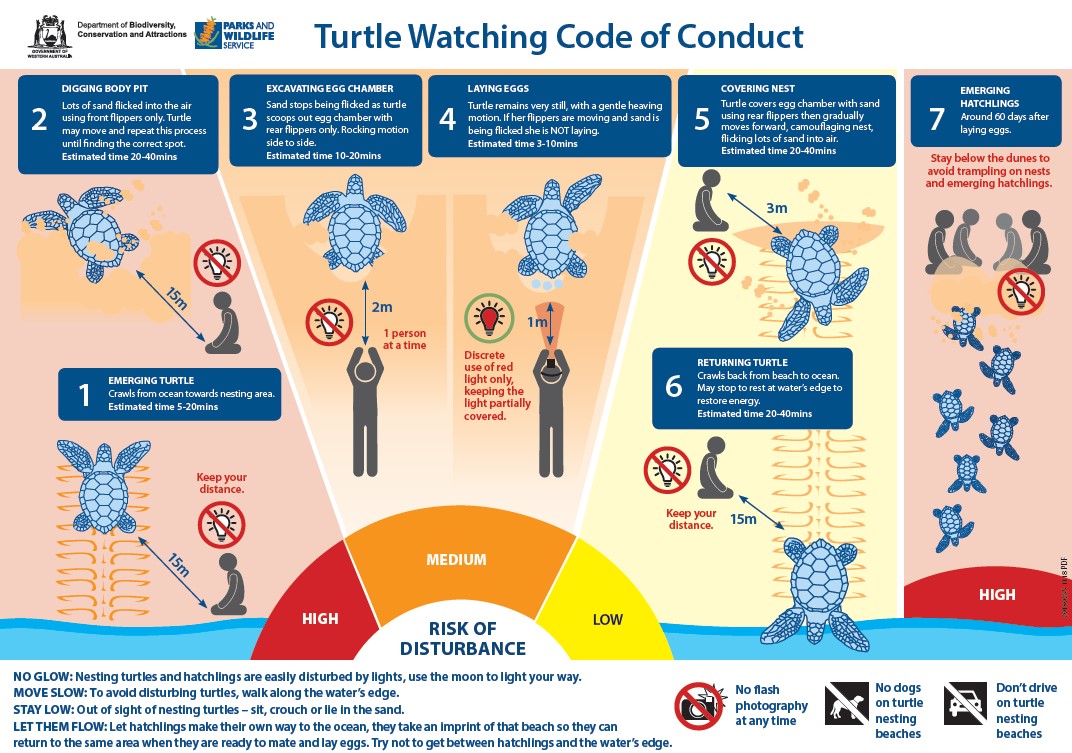Watching turtles lay their eggs is an awe-inspiring experience.
Follow these three rules to keep you and nesting turtles safe:
No glow
Move slow
Stay low
There are different stages of nesting you can watch, and different distances to keep when they’re happening. Read on below to discover how to safely watch nesting turtles.

Turtle watching - know your nesting stages and distances:
When a turtle is emerging (crawling from the ocean to their nesting area), they are very sensitive to light and movement on the beach. Keep all lights off, crouch low and stay at least 15 metres away until the turtle has found her nesting spot and is actively digging. It may take the turtle from 5 to 20 minutes to begin digging, and at that point you will be able to see and hear sand flicking.
Turtles dig a body pit (a large hole about the size of their body) before they dig their nest. When bodypitting, she will flick sand up and away using all of her flippers, and you may hear her breathing heavily. It's important to stay 15 metres away, as she may not find a suitable spot to nest and move elsewhere. She is very aware of her surroundings at this stage of nesting and will be sensitive to light and movement. Keep all lights off, crouch low and keep your distance.
When the turtle begins to excavate her egg chamber, you will notice sand stops flicking and her front flippers become still. Her rear flippers do all the work scooping out sand to create a 50 centimetre deep chamber where she will lay her eggs. She may have a slight side-to-side rocking motion during this time. It will take between 5 to 20 minutes to excavate her nest, and one person at a time can move up to two metres behind her to have a look. Keep lights off and crouch or lie on the sand.
When the turtle's rear flippers stop moving and she becomes very still, she will begin laying her 50 to 70 eggs. During this stage, turtles are not sensitive to their surroundings so you are able to move up to one metre behind her to watch the eggs are they are laid. You may use red light discretely (only one torch should be pointed towards the turtle at any time) and never point light towards a turtle's face. Egg-laying is quite quick, with the process over in three to ten minutes.
Once her eggs are laid, the turtle will cover the egg chamber with sand using her rear flippers. Once the rear flippers begin moving, move back so you are over three metres away from the turtle, staying behind and out of her sight. Make sure you have turned any lights off now. She will take 20 to 40 minutes to cover the egg chamber and camouflage her nest, which will involve more sand being flicked from the front flippers too. For your safety, it is best to move further back once her front flippers begin moving.
Once the turtle finishes covering and camouflaging her nest, she will crawl from the beach back to the ocean. She is very aware of her surroundings again, and tired after her nesting. Keep your distance to avoid stressing the turtle and so if she needs to stop to rest at the water's edge before entering the ocean, she is able. Keep your lights off and crouch low.
Join us on a Nest Quest!
It’s turtle nesting season along WA’s coast! Follow our ‘Nest Quest’ videos to learn about DBCA’s turtle monitoring programs and see the Turtle Watching Code of Conduct in action to keep yourself and the turtles safe!
Nest Quest Day 1
Day 1 shows Clodagh, the NWSFTCP Science Communication and Education Officer, departing Perth to Exmouth on the Nest Quest.
Learn about the Ningaloo Turtle Program and Jurabi Turtle Centre with program coordinator Dani Rob.
Clodagh will then head out at sunset to watch turtles coming up to nest, following the Turtle Watching Code of Conduct.
Nest Quest Day 2
Day 2 explores the Ningaloo Turtle Program's monitoring activities with coordinator Dani Rob.
Clodagh will join Dani for a morning track count, where she explains the monitoring process and threats to turtles at Ningaloo.
Nest Quest Day 3
Day 3 follows Clodagh leaving Ningaloo and taking a small airplane over Exmouth Gulf to Thevenard Island.
The North West Shelf Flatback Turtle Conservation Program runs annual monitoring at Thevenard Island, and it is the perfect place for a Nest Quest for flatback turtles. Join Clodagh as she joins the team of volunteers and demonstrates some of the monitoring activities of the North West Shelf Flatback Turtle Conservation Program.
Nest Quest Day 4
Day 4 features the Onslow School Year 7 students as they continue the Nest Quest with Clodagh on Thevenard Island on their annual Turtle Camp.
Join the group as they demonstrate the Turtle Watching Code of Conduct in action, identify turtle tracks, and perform a nest excavation.
Nest Quest Day 5
Day 5 is our final day of the Nest Quest!
Join Clodagh, Onslow School students and the North West Shelf Flatback Turtle Conservation Program volunteers as they demonstrate the Turtle Watching Code of Conduct in action and do turtle track counting.






